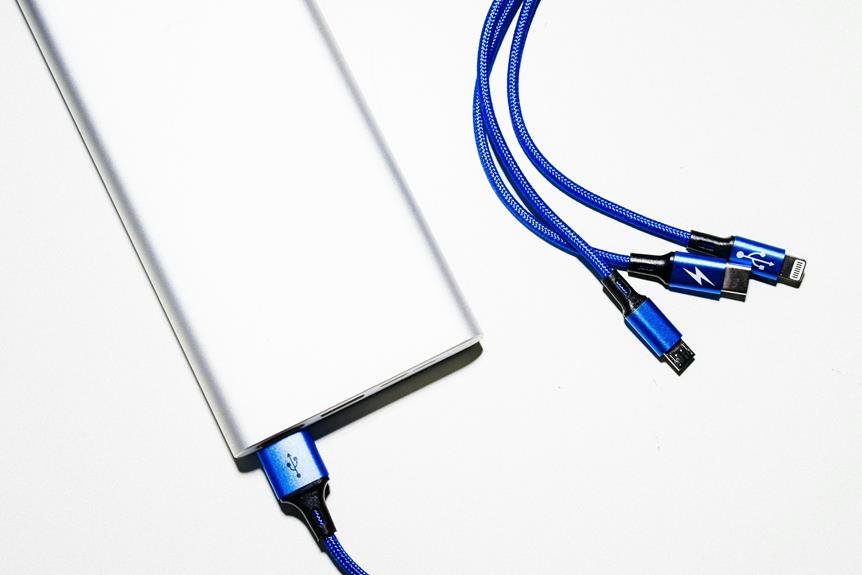Your power bank might not be charging due to several reasons. First, check if your charging cable is faulty by testing it with another device. Inspect the power bank's charging port for damage or debris. Confirm your power source is stable and aligns with the power bank's requirements. Sometimes, a depleted battery needs an extended period to charge up. Avoid using the power bank in hot conditions to prevent overheating. Firmware issues or internal component failures can also be culprits. Taking these steps will help you troubleshoot most charging problems and potentially find all-encompassing solutions.
Faulty Charging Cable
A common reason your power bank isn't charging could be a faulty charging cable, which can impede the proper transfer of power. To verify this isn't the issue, first check the cable compatibility with both your power bank and charging source. Incompatible cables might not support the correct voltage or current, leading to charging failures. Look at the charging indicator on your power bank; if it's not lighting up, the cable could be the culprit.
Next, consider the risks associated with overcharging and voltage fluctuations. A damaged or low-quality cable can cause inconsistent power delivery, potentially leading to overcharging risks or even damaging your power bank's internal components. Voltage fluctuations can further exacerbate these issues, as an unsteady power supply can harm both your power bank and the device it's intended to charge.
To troubleshoot, test the cable with another device to see if it charges properly. If it doesn't, you've identified the faulty component. Replacing it with a high-quality, compatible cable can solve the problem and safeguard against further issues like voltage fluctuations and overcharging risks, guaranteeing your power bank functions reliably.
Damaged Charging Port
Often, a damaged charging port can prevent your power bank from charging properly. This issue can arise from wear and tear, improper handling, or debris accumulation. To diagnose if the charging port is indeed the problem, inspect it closely. Look for any visible damage, such as bent pins or foreign objects lodged inside. If the port appears clean but still doesn't work, the internal connections may be compromised.
For repair options, you have a few choices. If you're technically inclined, you might attempt a DIY repair using tools like precision screwdrivers and soldering equipment. Online tutorials can guide you through the process. However, this approach can void any warranties and might not be suitable for everyone. Alternatively, consider professional repair services. Many electronics repair shops can fix charging ports at a reasonable cost, preserving your power bank's longevity.
Prevention tips are equally important. Always insert and remove cables gently to avoid stressing the port. Keep the charging port clean by using compressed air, and store your power bank in a dust-free environment. By following these measures, you can extend the life of your device and enjoy uninterrupted power on the go.
Insufficient Power Source
If the charging port is intact yet your power bank still won't charge, the issue might lie with an inadequate power source. First, assess the power outlet you're using. Sometimes, wall sockets can experience power fluctuations, which might not provide a stable current required for charging. It's essential to verify that the power outlet is reliable and free from any electrical anomalies.
Next, consider the type of charger you're using. Not all chargers are created equal. Some might provide an insufficient power supply, especially those with lower wattage ratings. Check the specifications on your power bank and compare them to your charger's output. If the charger's output (measured in volts and amps) doesn't match or exceed the power bank's requirements, it simply won't charge efficiently, if at all.
Additionally, USB ports on computers can sometimes be underpowered, particularly on older models. If you're charging through a computer, try switching to a wall adapter that meets the power bank's specifications. Lastly, using a high-quality, certified charging cable can minimize the risk of inadequate power transfer. By troubleshooting these elements, you can confirm that your power source is sufficient and consistent, enabling your power bank to charge effectively.
Depleted Power Bank Battery
When your power bank won't charge, a completely depleted battery could be the underlying issue demanding immediate attention. First, understand that batteries have a limit on how low they can go before they can't recharge properly. If your power bank's battery is entirely drained, it may struggle to begin charging again. This situation often results from poor charging habits, such as consistently letting the battery run down to zero before recharging.
To troubleshoot, start by connecting your power bank to a reliable power source and leave it for an extended period, even if there's no immediate response. Sometimes, a depleted battery needs a longer time to regain enough charge to show signs of life.
Battery maintenance is essential in preventing this issue. Aim to keep your power bank between 20% and 80% charged for best performance and longevity. Avoid letting it discharge completely unless absolutely necessary. Regularly monitoring your charging habits can greatly extend your power bank's lifespan and reliability.
If these steps don't resolve the problem, it could indicate that the battery has degraded beyond recovery, necessitating a replacement. Always make sure you're using the correct charger and cable to avoid further complications.
Overheating Issues
You're likely encountering overheating issues if your power bank isn't charging properly. High environmental temperatures, continuous usage, and poor ventilation design can all contribute to this problem. To identify the root cause, consider where and how you're using the device.
High Environmental Temperatures
Excessive environment temperatures can cause your power bank to overheat, leading to charging inefficiencies and potential damage. When your power bank is exposed to high temperatures, it can struggle to maintain its peak charging performance. This overheating can degrade the battery's overall lifespan and reduce its capacity, making it less efficient over time.
To avoid overheating, make sure that your power bank is compatible with the environmental conditions you're exposing it to. Always check the manufacturer's specifications for the best operating temperature range. Here are a few practical steps you can take to mitigate overheating risks:
- Avoid direct sunlight: Keep your power bank out of direct sunlight, especially during hot days, to prevent it from absorbing excessive heat.
- Use in shaded areas: If you're outdoors, try to use your power bank in shaded or cooler areas to maintain a stable temperature.
- Monitor charging sessions: Avoid charging your power bank in extremely hot environments. If needed, move to a cooler place temporarily.
Continuous Usage Impact
Continuous usage of your power bank can lead to overheating issues, diminishing its efficiency and potentially causing long-term damage. When a power bank is used continuously, the internal components generate heat. Excessive heat can degrade the battery capacity, reducing how much charge it can store and deliver. This not only affects the charging speed but also shortens the battery life.
From a technical standpoint, heat accelerates the chemical reactions within the battery, leading to quicker wear and tear. Over time, you might notice that your power bank doesn't hold a charge as well as it used to, indicating a drop in battery capacity. This, in turn, affects the power bank's durability, making it less reliable for your on-the-go charging needs.
To mitigate these issues, consider allowing your power bank to cool down between uses. Avoid charging it immediately after discharging, and refrain from using it while it's charging. This gives the internal components a chance to dissipate heat, preserving both the battery life and the overall power bank durability. By managing the heat effectively, you can maintain the best charging speed and extend the longevity of your device.
Poor Ventilation Design
Another important factor contributing to overheating issues is the poor ventilation design of many power banks. When a power bank lacks sufficient airflow, heat buildup becomes inevitable, leading to diminished performance and potential safety hazards. You may notice your power bank heating up unusually during charging or discharging phases. This overheating can hinder the charging process or even damage the internal components, making it essential to address.
To tackle this problem, consider the following ventilation improvement and cooling solutions:
- Ensure Adequate Airflow: Position your power bank in a well-ventilated space, avoiding enclosed areas that trap heat.
- Check for Built-in Cooling Mechanisms: Some high-quality power banks feature internal cooling fans or heat-dissipating materials.
- Upgrade to Better Designs: Choose power banks with enhanced ventilation features like perforated casings or heat sinks.
Firmware Problems
Firmware issues can often be the culprit behind a power bank not charging, requiring a firmware update or reset to restore functionality. When firmware becomes outdated or corrupted, it can lead to various compatibility issues with both the power bank's internal components and the devices you're trying to charge.
To address this, start by checking if the manufacturer offers any firmware updates. These updates can resolve bugs, enhance performance, and secure compatibility with newer devices. Visit the manufacturer's website and look for firmware update instructions tailored to your specific model. Downloading and installing these updates can often resolve charging issues immediately.
If firmware updates don't solve the problem, you might need to perform a firmware reset. This procedure varies by model but often involves holding down specific buttons for a set period. Refer to your power bank's user manual for detailed instructions.
Internal Component Failure
If firmware updates or resets don't resolve the issue, you might be facing internal component failure within the power bank. This can be more complex to diagnose, requiring a methodical approach to identify the faulty components. Before diving into power bank disassembly, make certain you've exhausted simpler troubleshooting steps.
Here are some signs that internal components might be the problem:
- Unusual noises or smells: If you hear buzzing or detect an unusual odor, it could indicate a failing internal component.
- Inconsistent charging: If the power bank charges irregularly or not at all, it might have a loose connection or damaged circuitry.
- Bulging or swelling: Physical deformation can be a sign of battery failure, which is hazardous and should be addressed immediately.
When you decide to proceed with power bank disassembly, make sure you have the right tools and follow safety precautions. Carefully inspect the circuit board, battery connections, and other internal parts. Look for any obvious damage, burned areas, or loose components. Replacing faulty parts often requires soldering skills and access to replacement components, which might not always be feasible.
Frequently Asked Questions
Can Extreme Temperatures Affect the Charging Efficiency of My Power Bank?
Extreme temperatures can certainly cripple the charging speed and battery lifespan of your power bank. Cold conditions can slow charging speed, while high heat can harm battery health. Keep your device in moderate temperatures for best performance.
How Do I Know if My Power Bank Is Compatible With My Device?
To verify compatibility, perform a compatibility check by confirming your device's voltage and current requirements. Check the power bank's charging indicators for appropriate output ratings. If both match, your power bank and device are compatible.
Is It Safe to Charge My Power Bank Overnight?
It's better to be safe than sorry. Charging your power bank overnight can shorten battery lifespan due to overcharging risk. Modern power banks have protections, but it's still wise to unplug once fully charged.
What Should I Do if My Power Bank Gets Wet?
If your power bank gets wet, immediately turn it off and use drying methods like silica gel to absorb moisture. Next, troubleshoot for functionality. Check your warranty coverage for potential repair options if issues persist.
How Often Should I Replace My Power Bank?
Think of your power bank's lifespan like a ticking clock. You'll typically need to replace it every 2-3 years due to battery degradation. Keeping track guarantees you're never left powerless when you need freedom most.



